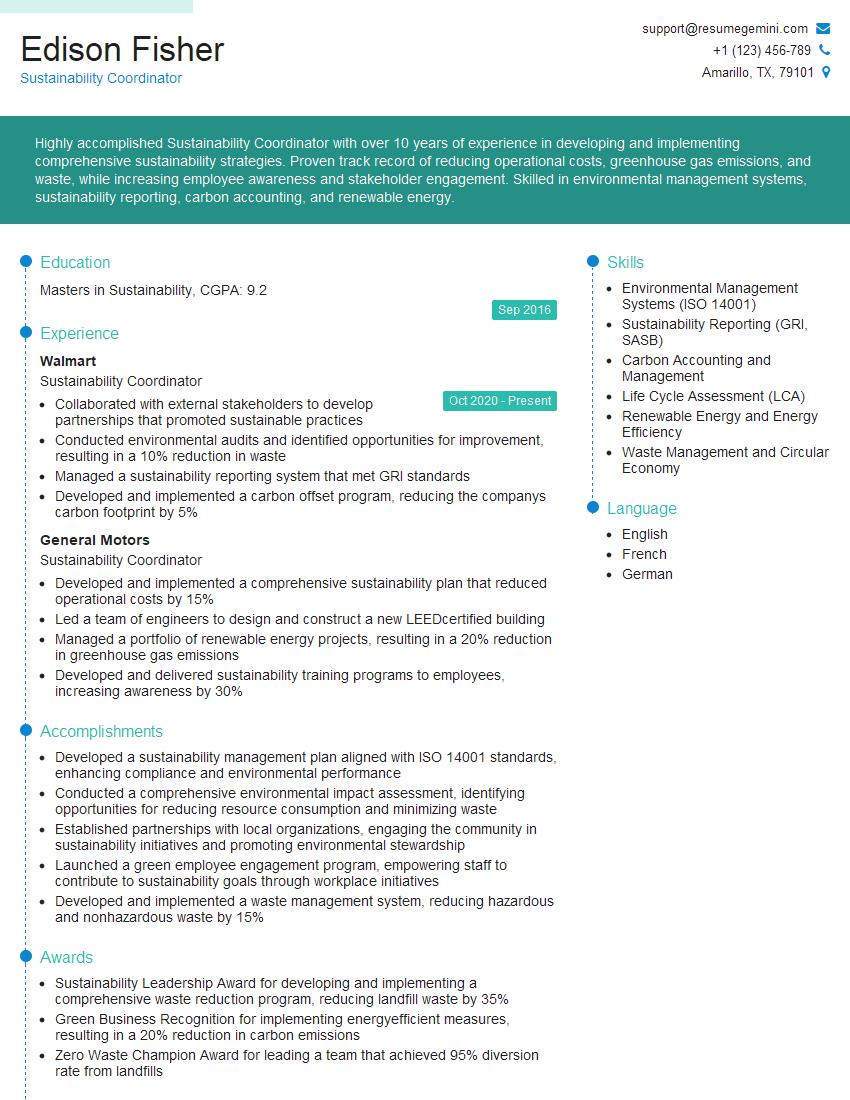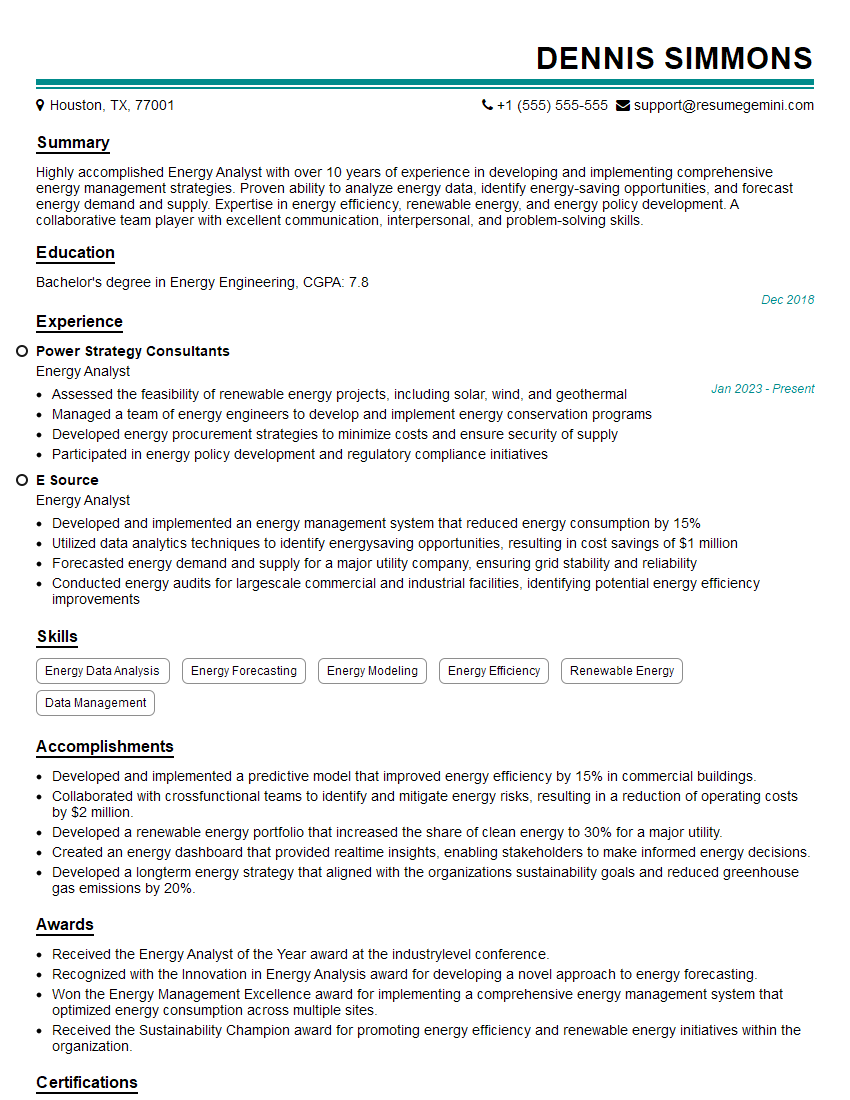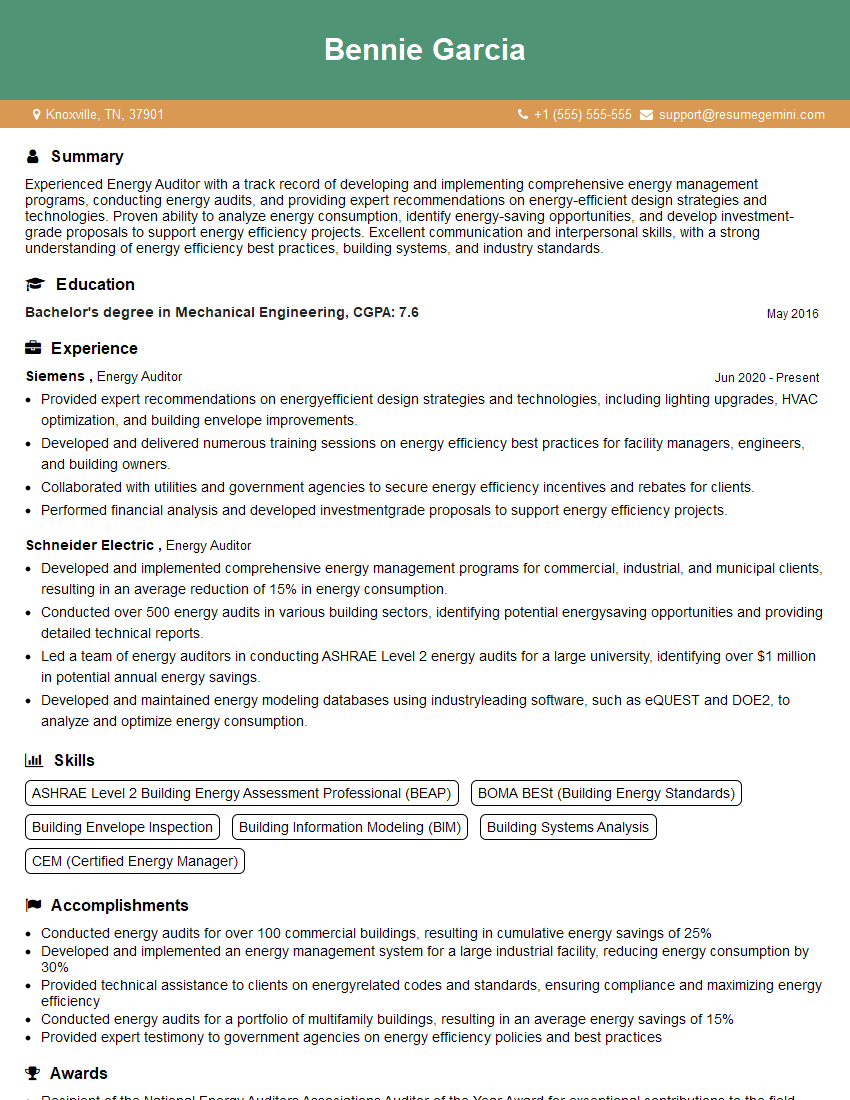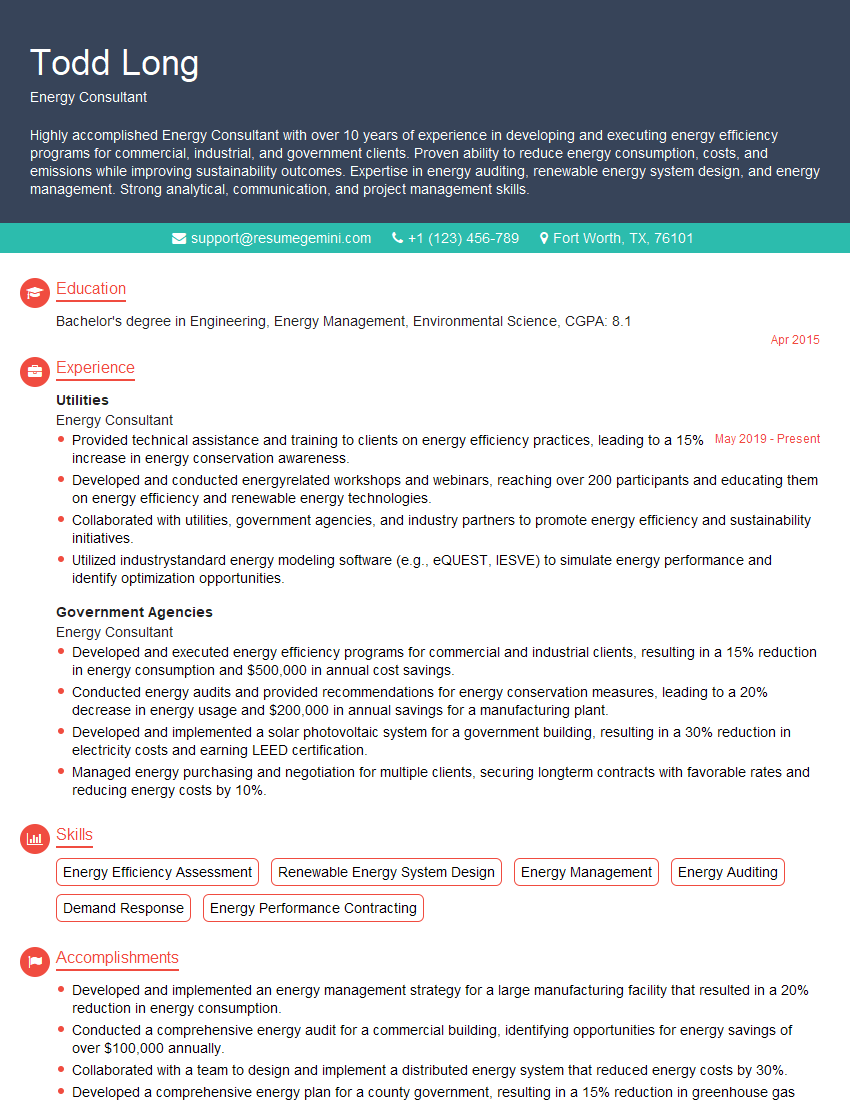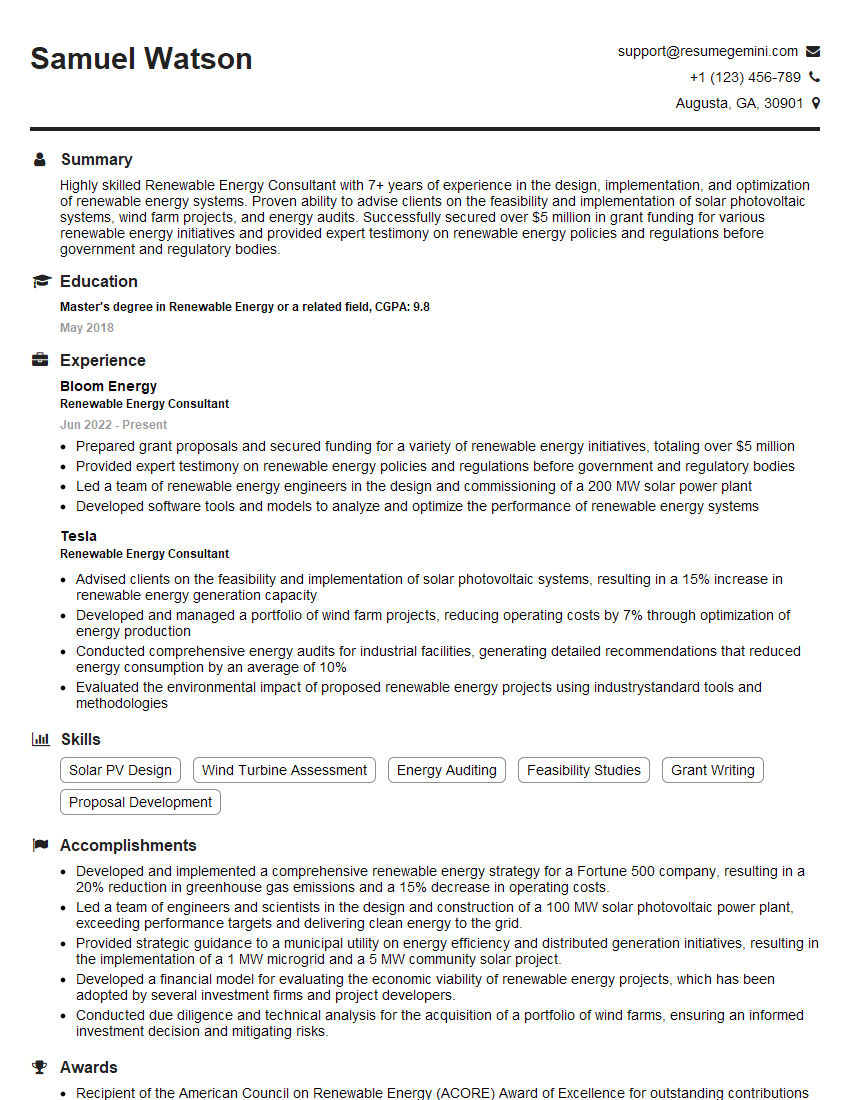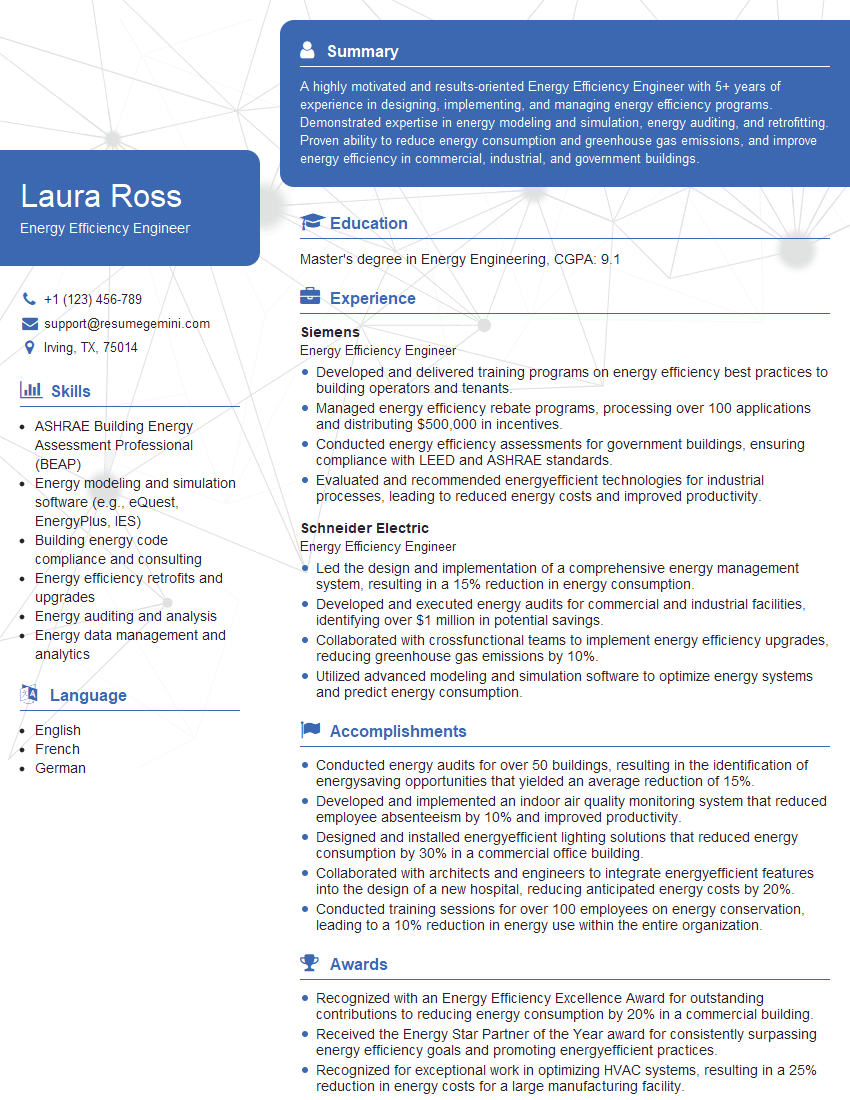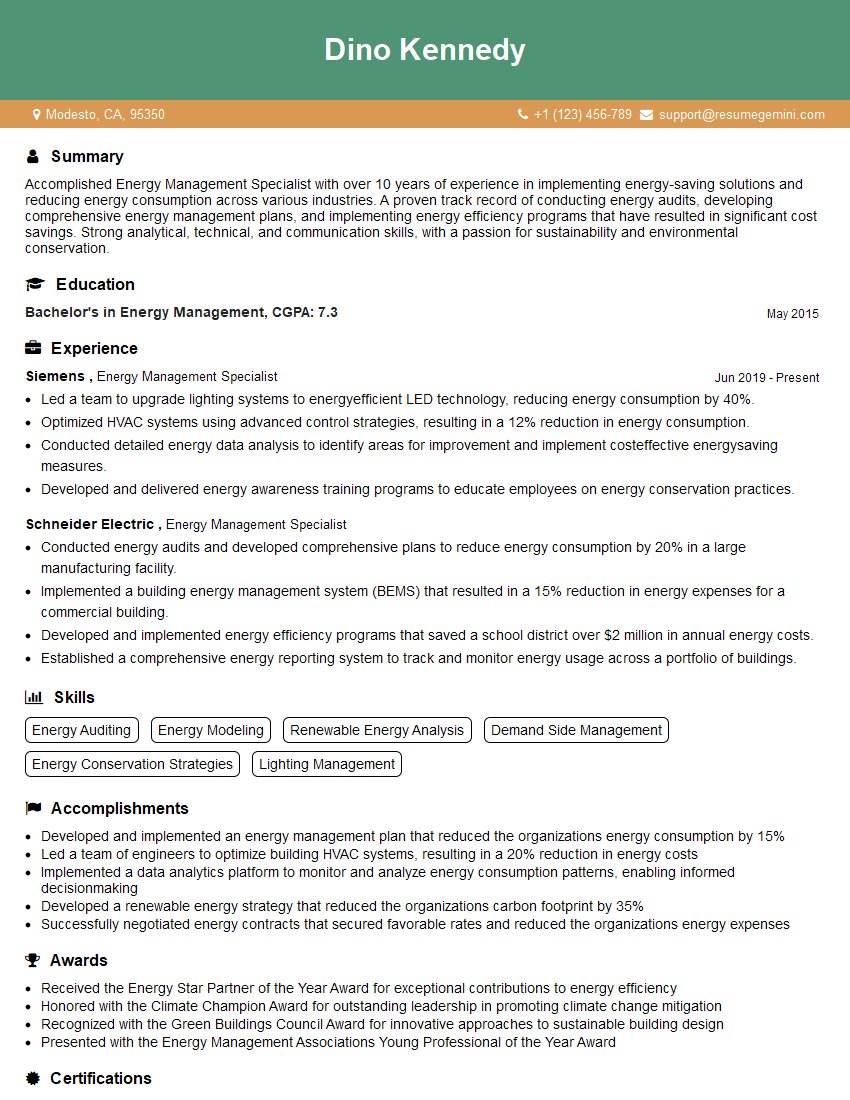Are you ready to stand out in your next interview? Understanding and preparing for Facility Energy Audits interview questions is a game-changer. In this blog, we’ve compiled key questions and expert advice to help you showcase your skills with confidence and precision. Let’s get started on your journey to acing the interview.
Questions Asked in Facility Energy Audits Interview
Q 1. Explain the process of conducting a typical facility energy audit.
A facility energy audit is a systematic process to assess a building’s energy performance, identify areas of waste, and recommend cost-effective improvements. Think of it as a comprehensive health checkup for your building.
- Pre-audit planning: This involves gathering initial data, scheduling site visits, and determining the scope of the audit (e.g., whole building, specific systems).
- Data collection: This is where we gather information on energy consumption patterns, building systems, and equipment. This includes reviewing utility bills, inspecting equipment, and measuring energy use through onsite testing. For example, we might use a thermal imager to detect heat loss through windows or walls.
- Site inspection/Walk-through: A thorough visual inspection of the building is crucial, noting aspects like insulation levels, window quality, HVAC system efficiency and building envelope conditions.
- Data analysis: This involves using specialized software to analyze energy consumption data, identifying trends, anomalies and areas of potential savings. Energy modeling software can also be used to simulate the effects of proposed energy efficiency measures.
- Report preparation and recommendations: The findings are summarized in a comprehensive report that details the energy consumption baseline, identifies energy-saving opportunities, and proposes cost-effective measures to reduce energy use and improve efficiency. This report includes a prioritized list of recommendations and estimated return on investment (ROI) for each measure.
Q 2. What are the key performance indicators (KPIs) used to assess energy efficiency in buildings?
Key Performance Indicators (KPIs) for building energy efficiency track progress and measure success. Think of them as the vital signs of your building’s energy health.
- Energy Use Intensity (EUI): This measures energy consumption per square foot (or meter) of building area (kWh/m² or kBtu/ft²). A lower EUI indicates better efficiency.
- Energy Cost per Square Foot: This reflects the direct cost of energy consumption per unit of area, providing a clear financial picture of energy efficiency.
- Carbon Footprint: This KPI quantifies the greenhouse gas emissions associated with building operations, focusing on environmental impact.
- Water Use Intensity (WUI): Though not directly energy-related, water heating consumes significant energy; tracking WUI helps optimize efficiency and reduce overall energy demands.
- HVAC System Efficiency (e.g., SEER, EER): These ratings for HVAC equipment measure energy efficiency and help determine if upgrades are needed.
By tracking these KPIs over time, we can evaluate the effectiveness of energy-saving measures and identify areas needing further attention.
Q 3. Describe different energy audit methodologies (e.g., walk-through, detailed).
Energy audit methodologies vary in depth and cost. Choosing the right approach depends on budget and the building’s complexity.
- Walk-through audit: This is a quick, less expensive overview. It involves a visual inspection of the building, reviewing utility bills, and identifying obvious energy waste opportunities. Think of it as a preliminary check-up, highlighting areas needing further investigation.
- Detailed energy audit: This is a more comprehensive audit. It involves detailed on-site measurements of energy use, equipment testing, and sophisticated modeling to pinpoint energy waste precisely. This is like a thorough medical examination with detailed tests.
- Energy Modeling: Advanced modeling techniques, often used in conjunction with detailed audits, allow us to simulate different energy efficiency scenarios and predict the impact of various improvements. This helps in optimizing strategies and improving accuracy.
Q 4. How do you identify and quantify energy waste in a building?
Identifying and quantifying energy waste requires a systematic approach.
- Analyze energy bills: Look for unusual spikes or trends in energy consumption. This provides a general overview of energy usage.
- Conduct a walk-through: Identify visible energy waste, such as poorly sealed windows or malfunctioning equipment. Thermal imaging can assist in finding hidden issues like air leaks.
- Perform on-site measurements: Use specialized instruments to measure energy consumption of individual systems and components. This gives precise data on energy use.
- Energy modeling: Use software to simulate energy consumption and identify potential savings from various energy efficiency measures. This helps in validating findings and improving accuracy.
For example, an unexpectedly high energy bill coupled with a visible air leak around a window might suggest significant energy loss through infiltration. Measuring the air infiltration rate would then quantify the extent of this energy waste.
Q 5. What are the common energy-saving measures for HVAC systems?
HVAC systems are major energy consumers. Efficiency improvements can significantly reduce energy use and operating costs.
- Upgrade to high-efficiency equipment: Replacing outdated HVAC equipment with newer, higher-efficiency models (e.g., high SEER/EER rated units) is often the most impactful measure.
- Optimize HVAC controls: Implementing advanced control systems, such as building automation systems (BAS), allows for precise control of temperature, ventilation, and operation schedules to match occupancy patterns and reduce energy waste.
- Regular maintenance: Keeping HVAC equipment well-maintained—including filter changes, cleaning, and regular inspections—is vital for optimal efficiency and prevents costly repairs.
- Improve ductwork: Sealing leaks in ductwork prevents energy loss and improves the efficiency of the entire system.
- Variable-speed drives (VSDs): VSDs help adjust motor speeds based on demand, reducing energy consumption during periods of low load.
Q 6. Explain the concept of building envelope and its impact on energy consumption.
The building envelope refers to the physical barrier separating the interior and exterior environments. Think of it as the building’s skin. Its condition greatly influences energy consumption.
A poorly performing building envelope allows for significant heat transfer, leading to increased heating and cooling demands. Leaks, poor insulation, and inefficient windows are common culprits. For example, a poorly insulated attic can lead to significant heat loss in winter and heat gain in summer, increasing energy consumption for both heating and cooling.
Improving the building envelope involves addressing issues such as air sealing, insulation upgrades, window replacement (with high-performance windows), and roof improvements (improving insulation and roofing material).
Q 7. How do you analyze energy consumption data to identify trends and anomalies?
Analyzing energy consumption data requires careful observation and the use of data analysis tools.
- Data visualization: Graphing energy consumption over time helps identify trends, seasonal variations, and unusual spikes. This visual representation is crucial for initial interpretation.
- Statistical analysis: Statistical methods, like regression analysis, can identify correlations between energy consumption and factors like weather conditions or occupancy levels. This provides a deeper understanding of driving forces behind energy use.
- Anomaly detection: Algorithms can be used to identify unusual data points that deviate from established patterns. These anomalies often point to equipment malfunctions or unexpected energy events.
- Benchmarking: Comparing the building’s energy performance to similar buildings provides a context for assessing efficiency. This helps identify areas needing improvement in comparison to peers.
For instance, a sudden increase in energy consumption during off-peak hours might indicate a malfunctioning piece of equipment operating continuously. Regression analysis could help verify whether the increase correlates with specific environmental factors or simply equipment malfunction.
Q 8. What software or tools do you use for energy modeling and analysis?
For energy modeling and analysis, I utilize a suite of software tools, each tailored to specific tasks. EnergyPlus is my go-to for detailed building simulation, allowing me to model the building’s energy performance under various scenarios and weather conditions. I use it to predict energy consumption, identify peak loads, and evaluate the impact of different energy efficiency measures. For example, I recently used EnergyPlus to model the impact of installing a new HVAC system on a large office building, resulting in a projected 20% reduction in energy consumption.
Alongside EnergyPlus, I leverage tools like eQUEST for quicker, less detailed analyses, particularly in early-stage assessments or preliminary design reviews. Finally, I use specialized data analysis software like Python with libraries such as Pandas and Matplotlib to process and visualize large datasets from energy metering equipment. This allows me to identify trends, anomalies, and opportunities for optimization within building energy consumption patterns.
Q 9. Describe your experience with ASHRAE standards related to energy efficiency.
My experience with ASHRAE standards is extensive, focusing primarily on standards related to energy efficiency in buildings. I’m intimately familiar with ASHRAE 90.1, the Energy Standard for Buildings Except Low-Rise Residential Buildings, and have applied its requirements in numerous projects. This includes performing energy audits according to its guidelines, identifying compliance issues, and recommending cost-effective upgrades to meet or exceed code requirements. I understand the nuances of the standard, including the different compliance paths and the implications of each.
Furthermore, I have experience with ASHRAE 62.1, which focuses on ventilation and indoor air quality. Understanding both standards is critical because energy-efficient designs often must balance energy savings with the need for healthy indoor environments. For instance, while highly efficient HVAC systems can reduce energy use, inadequate ventilation can compromise indoor air quality. My work involves navigating this balance to deliver effective and sustainable building designs.
Q 10. How do you prioritize energy-saving projects based on cost-effectiveness?
Prioritizing energy-saving projects relies heavily on a robust cost-effectiveness analysis. I typically utilize the Simple Payback Period (SPP) and Return on Investment (ROI) methods. The SPP is calculated by dividing the initial investment cost by the annual energy savings. A shorter payback period signifies a quicker return on investment. The ROI, on the other hand, expresses the return as a percentage of the investment.
However, I go beyond these simple metrics. I also consider factors like the project’s lifespan, potential for future savings, and the project’s alignment with the building’s long-term goals. For example, a project with a slightly longer payback period might be prioritized if it addresses a critical system deficiency that could lead to higher maintenance costs in the future. I often present clients with a prioritized list of projects ranked by SPP, ROI, and a qualitative assessment of the risks and benefits, allowing them to make informed decisions aligned with their financial and operational priorities.
Q 11. What are your experiences with different types of energy metering equipment?
My experience encompasses a range of energy metering equipment, from basic kilowatt-hour (kWh) meters to sophisticated sub-metering systems and advanced data loggers. I’ve worked with electromechanical meters, solid-state electronic meters, and smart meters capable of communicating data wirelessly. This experience allows me to select the right equipment for specific projects based on factors such as accuracy requirements, data resolution, communication capabilities, and budget. For example, for a comprehensive energy audit of a large industrial facility, I might deploy a combination of sub-meters to measure energy consumption at individual equipment levels, smart meters for real-time monitoring, and data loggers to capture detailed usage patterns.
I am also proficient in interpreting the data collected from these meters, using specialized software to analyze consumption patterns and identify opportunities for energy savings. This includes identifying anomalous consumption periods, pinpointing energy-intensive equipment, and verifying the effectiveness of implemented energy-saving measures.
Q 12. How do you communicate complex technical information to non-technical audiences?
Communicating complex technical information to non-technical audiences is a critical skill in my profession. I achieve this through clear, concise language, avoiding jargon whenever possible. Instead of using technical terms like ‘enthalpy’ or ‘psychrometrics’, I prefer to use everyday language and relatable analogies. For instance, I might explain the concept of building thermal envelope by using the analogy of a well-insulated thermos to explain how a building retains heat or cold.
I also use visuals extensively, including charts, graphs, and infographics. These tools are extremely effective in conveying data and trends in a way that everyone can understand. For example, a simple bar chart clearly illustrating the cost savings from proposed energy efficiency upgrades is much more impactful than a lengthy technical explanation. Finally, I always tailor my communication style to the specific audience. A presentation to a board of directors will differ significantly from a conversation with facility maintenance staff.
Q 13. Explain your experience with energy audits in different building types (e.g., commercial, industrial).
I have conducted energy audits in a wide variety of building types, including commercial office buildings, industrial plants, educational facilities, and retail spaces. Each type of building presents unique challenges and opportunities for energy savings. For instance, commercial buildings often have complex HVAC systems, requiring careful analysis of their operation and efficiency. Industrial facilities may have large energy-intensive equipment requiring specialized assessments to identify areas for optimization.
My approach to each audit is consistent: I start by reviewing building plans, utility bills, and operational data. I then conduct a site visit to collect data on the building’s systems, equipment, and envelope. Finally, I analyze the data using software tools like those mentioned previously to identify areas for improvement. My reports typically include recommendations for energy-saving measures, including cost estimates and payback periods. This structured approach ensures that the audit is thorough and provides actionable insights for the building owner or manager.
Q 14. What is your experience with energy retrofits and commissioning?
I have significant experience with both energy retrofits and commissioning. Energy retrofits involve upgrading existing building systems and components to improve energy efficiency. This can range from simple measures like replacing inefficient lighting fixtures with LEDs to more complex upgrades like installing high-efficiency HVAC systems or improving the building envelope. Commissioning, on the other hand, is the process of verifying that building systems are operating as designed and intended.
My role in retrofits typically includes identifying cost-effective upgrades, overseeing the implementation of the upgrades, and verifying the actual energy savings achieved after implementation. In commissioning, I follow established procedures to test and adjust systems to ensure optimal performance. I often combine both retrofits and commissioning in projects, for example by retrofitting outdated HVAC equipment and then commissioning the new system to verify its performance. The result is a building that functions efficiently, reliably, and sustainably.
Q 15. How familiar are you with energy codes (e.g., IECC, ASHRAE 90.1)?
Energy codes, such as the International Energy Conservation Code (IECC) and ASHRAE Standard 90.1, are crucial for building energy efficiency. They establish minimum requirements for energy performance in new and renovated buildings. I’m intimately familiar with both. The IECC provides a prescriptive path, outlining specific requirements for building components like insulation, windows, and HVAC systems. ASHRAE 90.1 offers a performance-based approach, allowing more flexibility in design while still meeting energy targets. My experience includes applying both codes in various projects, understanding their nuances, and navigating the complexities of compliance, particularly when dealing with existing buildings that need to be brought up to code or meet equivalent standards.
For instance, I recently worked on a project where we used ASHRAE 90.1 to optimize the HVAC system in a large office building, resulting in a 15% reduction in energy consumption. This involved careful modeling and simulation to ensure compliance while maximizing energy savings.
Career Expert Tips:
- Ace those interviews! Prepare effectively by reviewing the Top 50 Most Common Interview Questions on ResumeGemini.
- Navigate your job search with confidence! Explore a wide range of Career Tips on ResumeGemini. Learn about common challenges and recommendations to overcome them.
- Craft the perfect resume! Master the Art of Resume Writing with ResumeGemini’s guide. Showcase your unique qualifications and achievements effectively.
- Don’t miss out on holiday savings! Build your dream resume with ResumeGemini’s ATS optimized templates.
Q 16. Describe your experience with incentive programs and rebates for energy efficiency.
Incentive programs and rebates are critical for making energy efficiency upgrades economically viable. My experience spans numerous programs offered at the local, state, and federal levels, including utility company initiatives and government-sponsored programs. I’m adept at identifying eligible projects, navigating the application processes, and maximizing the financial benefits available to my clients. I understand the specific requirements, deadlines, and reporting mechanisms for each program.
For example, I successfully secured a significant rebate for a client upgrading their lighting system to LEDs through a utility company’s energy efficiency program. This reduced their upfront investment and significantly accelerated their return on investment.
Q 17. What are the common challenges encountered during facility energy audits?
Facility energy audits often encounter several challenges. One common hurdle is incomplete or inaccurate data. Building management systems (BMS) might be outdated or improperly configured, hindering accurate data collection. Another is gaining access to all building areas for thorough inspections. Limited access can result in incomplete assessments and inaccurate conclusions.
- Data Acquisition Challenges: Lack of properly functioning metering equipment, missing historical data, and difficulty in accessing relevant information from building management systems.
- Building Access Issues: Restricted access to certain areas or equipment, impacting the thoroughness of the inspection and data collection.
- Stakeholder Resistance: Concerns from building occupants or management about the audit process and its potential disruptions.
- Budgetary Constraints: Limited funding for thorough audits, leading to a less comprehensive assessment and fewer recommended improvements.
Successfully navigating these challenges requires careful planning, effective communication, and a flexible approach.
Q 18. How do you address stakeholder concerns during the energy audit process?
Addressing stakeholder concerns is paramount to a successful energy audit. Proactive and transparent communication is key. I begin by clearly explaining the audit’s purpose, methodology, and expected outcomes to all stakeholders. I emphasize the potential benefits – cost savings, environmental responsibility, and improved building comfort. I also address potential disruptions and concerns about the audit process, answering questions openly and honestly. This builds trust and cooperation. I actively solicit feedback and incorporate it into the process.
For example, in one project, building occupants were concerned about potential disruptions to their work during the audit. By scheduling inspections during off-peak hours and communicating the process clearly, I minimized disruptions and allayed their concerns.
Q 19. Explain your understanding of Life Cycle Cost Analysis (LCCA).
Life Cycle Cost Analysis (LCCA) is a crucial tool for evaluating the long-term economic viability of energy efficiency projects. It considers all costs associated with an improvement over its lifespan, including initial investment, operation, maintenance, and replacement costs. By comparing the LCCA of different options, we can identify the most cost-effective solution that provides the best overall return on investment.
For example, when considering whether to replace an existing HVAC system, an LCCA would compare the costs of a high-efficiency system with a less-efficient, cheaper option. While the initial investment might be higher for the high-efficiency system, its lower operating and maintenance costs over its lifetime could make it the more economical choice.
Q 20. Describe your proficiency with energy management systems (EMS).
My proficiency with Energy Management Systems (EMS) is extensive. I understand how EMS collect, process, and analyze energy consumption data from various building systems. I can use this data to identify energy waste, diagnose system malfunctions, and verify the effectiveness of energy efficiency measures. I’m experienced with various EMS platforms, understanding their capabilities and limitations.
In practice, I use EMS data to track energy consumption trends, identify anomalies, and optimize building operations. For example, I recently used an EMS to identify a faulty chiller that was consuming excessive energy. This allowed for timely repairs and significant energy savings.
Q 21. How do you ensure the accuracy and reliability of your audit findings?
Ensuring accuracy and reliability in audit findings is critical. My approach involves a multi-faceted strategy:
- Data Validation: Cross-checking data from multiple sources (e.g., utility bills, BMS data, on-site measurements) to ensure consistency and identify discrepancies.
- Calibration and Verification: Using calibrated instruments and verifying measurements against established standards.
- Peer Review: Having another qualified professional review the findings to ensure accuracy and identify potential biases.
- Quality Assurance Procedures: Following a well-defined methodology and documented procedures to ensure consistency and reduce errors.
By employing these methods, I maintain a high level of confidence in the accuracy and reliability of my audit reports, providing clients with dependable information for making informed decisions.
Q 22. What is your experience with data logging and analysis in building energy audits?
Data logging and analysis are crucial for accurate building energy audits. I’ve extensively used various data loggers – from simple handheld devices measuring temperature and humidity to sophisticated systems capable of monitoring hundreds of data points simultaneously, including electricity consumption, gas usage, and even occupancy patterns. My analysis typically begins with data cleaning and validation to remove any erroneous readings. Then, I use statistical methods and energy modeling software (like EnergyPlus or eQuest) to identify trends, pinpoint energy-consuming equipment, and understand the building’s operational characteristics. For example, in one audit, data logging revealed that a seemingly insignificant air leak was responsible for a significant portion of heating energy loss, leading to targeted and cost-effective remediation.
I often utilize visual tools like graphs and charts to clearly illustrate energy usage patterns, making it easier for building owners to grasp the situation. My experience extends to analyzing data from Building Automation Systems (BAS) to integrate real-time building performance data into my analysis. This provides a holistic view, going beyond just static energy consumption figures.
Q 23. Explain your understanding of different energy efficiency technologies (e.g., LED lighting, smart thermostats).
Energy efficiency technologies offer significant opportunities for reducing building energy consumption. I’m familiar with a wide range of them, and I always select technologies that best suit the specific building’s needs and budget constraints. Let’s take a few examples:
- LED Lighting: LEDs offer significantly higher energy efficiency and longer lifespans compared to incandescent or fluorescent lights. I often recommend LED retrofits as a quick and easy win, focusing on lighting controls like occupancy sensors and daylight harvesting to further optimize their performance.
- Smart Thermostats: These programmable thermostats learn occupancy patterns and adjust temperatures accordingly, reducing energy waste from heating and cooling. I assess the suitability of different smart thermostat types, depending on the building’s existing control system. Some allow for remote monitoring and control, adding another layer of management.
- High-efficiency HVAC equipment: This includes heat pumps, variable refrigerant flow (VRF) systems, and high-efficiency boilers. Their selection requires careful consideration of factors like climate, building load, and potential integration with renewable energy sources. We often use software to model the performance of different systems to ensure optimal selection.
- Building Envelope Improvements: This encompasses things like insulation upgrades, window replacements, and air sealing. These are often more expensive upfront, but deliver long-term energy savings, reducing heating and cooling loads.
The selection process involves a detailed cost-benefit analysis to ensure that chosen technologies offer a suitable return on investment.
Q 24. How do you determine the payback period for proposed energy-saving measures?
Determining the payback period is essential for justifying energy-saving measures. It’s calculated by dividing the initial investment cost of a measure by the annual energy cost savings it generates. For example, if a project costs $10,000 and saves $2,000 annually, the payback period is 5 years (10,000 / 2,000 = 5).
However, a simple payback period calculation is rarely sufficient. A comprehensive analysis considers factors like:
- Maintenance costs: Regular maintenance is crucial for energy efficiency measures. The cost of future maintenance needs to be factored into the calculation.
- Incentives and rebates: Many governments offer financial incentives for implementing energy-efficient technologies. These can significantly shorten the payback period.
- Discount rate: The discount rate reflects the time value of money. It accounts for the fact that money received in the future is worth less than money received today.
- Energy price escalation: Future energy prices are likely to increase. This should be considered for a more accurate long-term analysis.
I use sophisticated financial modeling tools to incorporate these factors, providing a robust assessment of the financial viability of energy efficiency upgrades.
Q 25. What is your experience with developing energy efficiency improvement plans?
Developing comprehensive energy efficiency improvement plans (EEIPs) is a core part of my work. This involves a systematic approach, starting with a thorough energy audit to identify areas for improvement.
The EEIP typically includes:
- Executive summary: A brief overview of the building’s energy consumption and proposed improvements.
- Energy consumption analysis: Detailed breakdown of energy usage by end-use.
- Recommended measures: A prioritized list of energy-saving measures, including technical specifications and cost estimates.
- Implementation plan: A timeline for implementing the recommended measures, including responsibilities and milestones.
- Financial analysis: Detailed cost-benefit analysis of each measure, including payback periods and return on investment (ROI).
- Monitoring and verification plan: A strategy for tracking the performance of implemented measures to ensure expected energy savings are achieved.
I always tailor the EEIP to the client’s specific needs and budget constraints, ensuring that the recommendations are practical, achievable, and cost-effective. I also prioritize measures that offer the fastest payback periods and highest ROI.
Q 26. How do you incorporate renewable energy sources into energy audit recommendations?
Incorporating renewable energy sources into energy audit recommendations is increasingly important. I assess the feasibility of various renewable options based on factors like the building’s location, size, and energy needs, as well as available roof space, sunlight exposure, and local regulations.
Commonly considered options include:
- Photovoltaic (PV) systems: Solar panels generate electricity directly from sunlight. I evaluate the potential energy generation, considering factors like panel efficiency, shading, and system orientation.
- Solar thermal systems: These systems use solar energy to heat water for domestic hot water or space heating. Feasibility depends on factors like climate and hot water demand.
- Wind turbines: In appropriate locations with sufficient wind resources, wind turbines can provide electricity generation.
- Geothermal systems: These systems utilize the relatively constant temperature of the earth to provide heating and cooling. Their suitability depends on geological conditions.
The integration of renewable sources often requires detailed engineering analysis to ensure proper system sizing, grid connectivity, and compliance with safety standards. I work closely with specialized engineers and contractors to ensure seamless implementation.
Q 27. Describe your experience with building automation systems (BAS) and their energy impacts.
Building Automation Systems (BAS) are sophisticated control systems that monitor and manage a building’s mechanical, electrical, and plumbing (MEP) equipment. My experience with BAS includes assessing their current performance, identifying areas for optimization, and recommending upgrades or modifications.
A well-managed BAS can significantly reduce energy consumption by:
- Optimizing HVAC operations: Controlling temperature, airflow, and ventilation based on occupancy and weather conditions.
- Improving lighting control: Adjusting lighting levels based on occupancy and daylight availability.
- Monitoring energy consumption: Providing real-time data on energy usage for better decision-making.
- Detecting equipment malfunctions: Early detection of equipment problems helps prevent energy waste and costly repairs.
However, poorly designed or maintained BAS can actually increase energy consumption. I assess the existing BAS functionality, identify any inefficiencies, and recommend upgrades or modifications to enhance energy savings. This might include upgrading control algorithms, improving sensor accuracy, and implementing more sophisticated monitoring tools. Data from the BAS is often integrated into my energy audits to provide a more accurate and complete picture of building energy performance.
Q 28. Explain your knowledge of building codes and regulations relevant to energy efficiency.
Knowledge of building codes and regulations relevant to energy efficiency is crucial for ensuring that recommended energy-saving measures are compliant and legally sound. I stay updated on the latest codes and standards, including ASHRAE standards (like ASHRAE 90.1), International Energy Conservation Code (IECC), and local building codes.
These codes typically cover aspects like:
- Building envelope requirements: Specifications for insulation, windows, and air sealing.
- HVAC system efficiency: Minimum efficiency standards for heating and cooling equipment.
- Lighting efficiency: Requirements for lighting power density and control systems.
- Renewable energy integration: Guidelines for incorporating renewable energy sources into building design.
Compliance with these codes is vital not only for legal reasons but also for ensuring the long-term effectiveness and sustainability of energy efficiency improvements. I integrate these requirements into my energy audit reports and recommendations, ensuring that all proposed measures meet or exceed the applicable codes and standards. I also advise clients on any potential exemptions or alternative compliance paths.
Key Topics to Learn for Facility Energy Audits Interview
- Building Envelope Analysis: Understanding heat transfer mechanisms (conduction, convection, radiation), identifying areas of thermal bridging, and assessing the impact of insulation and window systems. Practical application: Analyzing building blueprints and energy modeling software outputs to pinpoint energy loss areas.
- HVAC Systems Assessment: Evaluating the efficiency of heating, ventilation, and air conditioning systems, including boiler/chiller plants, air handling units, and ductwork. Practical application: Interpreting system performance data, identifying opportunities for optimization (e.g., controls upgrades, equipment retrofits).
- Lighting Systems Analysis: Assessing lighting power density, evaluating the efficiency of lighting fixtures, and identifying opportunities for energy-efficient lighting upgrades (LEDs, controls). Practical application: Conducting lighting surveys, calculating energy savings from proposed upgrades.
- Energy Modeling and Simulation: Utilizing software tools (e.g., EnergyPlus, eQuest) to model building energy performance and simulate the impact of energy efficiency measures. Practical application: Developing energy models, interpreting simulation results to inform retrofit strategies.
- Data Acquisition and Analysis: Collecting and analyzing energy consumption data from utility bills, building management systems (BMS), and metering equipment. Practical application: Identifying energy consumption patterns, pinpointing areas of high energy use, and validating energy savings from implemented measures.
- Energy Auditing Standards and Reporting: Familiarity with industry standards and best practices for conducting energy audits (e.g., IPMVP). Practical application: Preparing comprehensive energy audit reports, clearly communicating findings and recommendations to clients.
- Energy Conservation Measures (ECMs): Understanding a wide range of ECMs, including behavioral changes, operational improvements, and capital improvements. Practical application: Developing cost-effective ECM packages that meet client objectives and maximize energy savings.
- Life-Cycle Cost Analysis (LCCA): Evaluating the long-term economic viability of ECMs by considering first costs, operating costs, and maintenance costs. Practical application: Performing LCCA to justify ECM investments and demonstrate return on investment (ROI).
Next Steps
Mastering Facility Energy Audits opens doors to rewarding careers in sustainable building practices and energy management. To maximize your job prospects, creating a strong, ATS-friendly resume is crucial. ResumeGemini is a trusted resource to help you build a professional resume that highlights your skills and experience effectively. We offer examples of resumes tailored to Facility Energy Audits to guide you in crafting your own compelling application materials.
Explore more articles
Users Rating of Our Blogs
Share Your Experience
We value your feedback! Please rate our content and share your thoughts (optional).
What Readers Say About Our Blog
Hi, I represent an SEO company that specialises in getting you AI citations and higher rankings on Google. I’d like to offer you a 100% free SEO audit for your website. Would you be interested?
good
